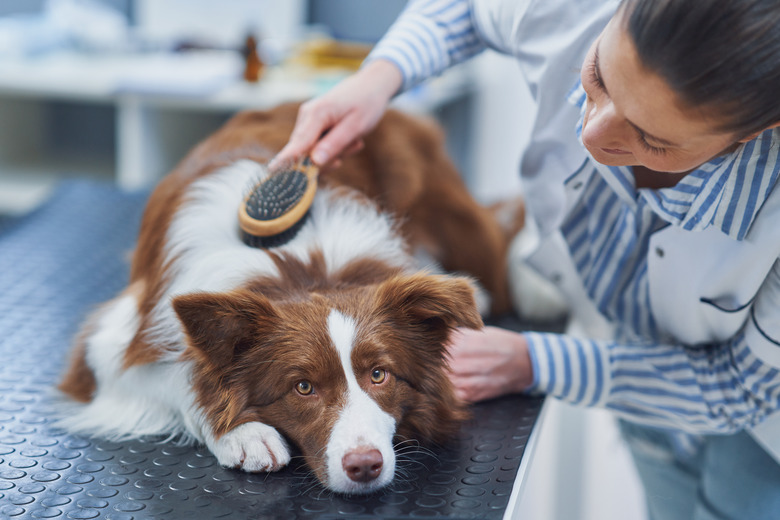What Does Fear Free Mean?
Even if you don't have an anxious or fearful dog or cat on your hands, chances are, there are some places that your canine or feline just doesn't enjoy going to — such as the vet's office or groomer. Although these spaces are intended to enhance your pet's well-being, they can sometimes trigger a pet. A new standard of education called "Fear Free" is working to create supportive environments for pets everywhere they go, turning what would have been a daunting task into a low stress part of the day. This new standard has been developed by veterinarians, behaviorists, pain experts, groomers, trainers, and other members of the pet wellness community. The Fear Free courses keep in mind the needs of the pet industry pros and consult pet owners when coming up with a plan to keep cats and dogs comfortable in a variety of settings.
Why Fear Free?
Why Fear Free?
If the name doesn't say enough already, implementing Fear Free practices for your dog comes with a number of benefits, the main one being that doing tasks essential for their well-being will be low-stress experiences, rather than extremely upsetting undertakings. The Fear Free practice, founded by veterinarian Dr. Marty Becker, works to alleviate stress, anxiety, and fear in pets, not by training those things out of them, but by educating the people around them. By creating supportive environments, pets are able to enjoy less fear in potentially stressful scenarios, like having blood drawn or having their nails clipped, for example. Signs of fear among dogs and cats include panting, pacing, cowering, and even snapping or scratching at those around them.
The standards adhered to under a Fear Free certified practice will vary depending on what that organization does, and there are seven categories that contain a mix of mandatory and optional standards: physical and emotional, client education, medical records, facilities, community education, culture, and patient observation. Generally speaking, Fear Free guidelines are humane, supervised, and follow varying levels of touch, including humane restraint, gentle touch and control, and consideration when approaching a pet. Understanding what pets need to feel safe is what helps create a Fear Free environment, and often, gentle touch, distraction with food, and calming praise are parts of that equation. Sometimes, synthetic pheromones can even be used to offer a sense of security around some pets, like cats, and may alleviate fear and stress in settings like a vet's office.
Fear Free versus Force Free
Fear Free versus Force Free
Fear Free practices are often confused with Force Free training methods, but the two are not the same. Force Free training is also known as positive reinforcement training, which encourages dogs to learn desired behaviors by rewarding them when they exhibit those traits, rather than punishing them for not doing it, or for doing the "wrong" thing. Like Fear Free education, force free training is considered humane and encourages people to work with their dog's abilities so that they learn over time without intimidation, aggression, or punishment. Unlike Fear Free, however, force free training focuses much more on teaching the dog rather than compromising the environment around that dog to remove triggers, rather than teaching them to be comfortable around those triggers.
That said, there is a place for both schools of thought as you simply cannot control everything that happens around your dog in the real world. Force free training methods are highly recommended when training your dog but is not the same as Fear Free education and practices.
Becoming a Fear Free certified professional
Becoming a Fear Free certified professional
Most people think that Fear Free implies only a dog training technique, but Fear Free practices are implemented in a variety of settings dogs find themselves in, including the veterinarian's office, the groomer's table, and also among pet sitters, rescue volunteers, and animal shelter staff. More and more pet professionals are becoming Fear Free certified. In order to receive a Fear Free certification, a pet care professional must complete the Fear Free certification program, which is completed online. In order to register, the trainee must qualify through a previous certification in their field, and must first be approved by completing an intake form that shows they exhibit a basic understanding and knowledge of Fear Free standards. To find a Fear Free certified professional in your area, you can search by practice in your area by clicking here.
In summary
In summary
Fear Free is not exactly a technique used to train dogs and cats. It is a set of standards and values used to encourage people in pet care settings to make these spaces less fearful or anxiety-inducing for pets. To become a Fear Free certified professional, one must successfully complete a Fear Free certification program, which is an online course given in seven parts. Fear Free is not the same as Force Free, or positive reinforcement training. Fear Free doesn't reward a pet for a behavior well done, but rather, educates human handlers on how to best meet a pet's needs.


